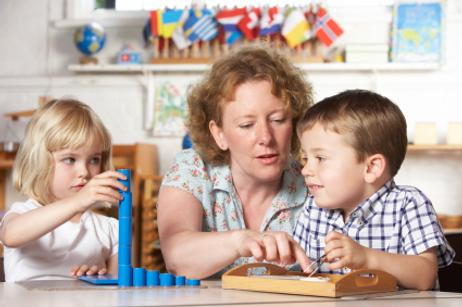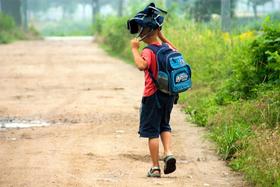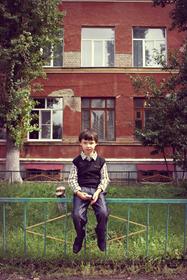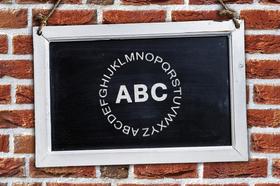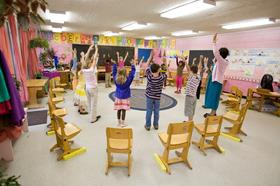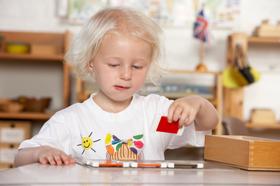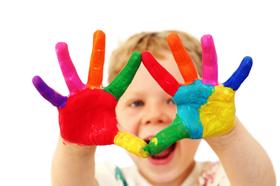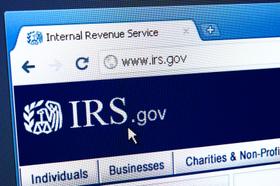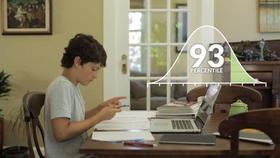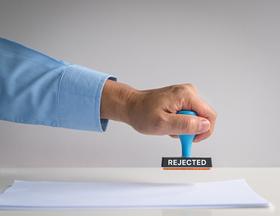Dr. Maria Montessori's first Casa de Bambini in Rome opened in 1906. That school and Dr. Montessori's methods were was so innovative and ahead of their time that word of Dr. Montessori and her methods spread quickly around Europe. By 1911 the first Montessori school opened in the United States. That school was located north of New York City in Tarrytown. When you consider that communications in the early twentieth century were slow, the fact that word about Dr. Montessori did spread so quickly was remarkable. One other fact worth noting is that Dr. Montessori began her work with disadvantaged children living in Rome's poorest neighborhoods. Yet when her approach found its way to the United States, it appealed strongly to middle-class parents who were looking for enlightened alternatives to the traditional educational methods found in American schools. The following video offers a brief history of Montessori.
Nowadays Montessori schools enjoy an enthusiastic following with approximately 4,000 certified schools in the U.S. Most of these are private schools offering the early or primary grades. Only about 200 public schools use the Montessori method or some version thereof. Because Dr. Maria Montessori did not trademark the name Montessori, any school can claim to be a Montessori school. Just because it says it is a Montessori school does not mean that it is the real thing. As a result you will have to be observant and aware of what to look for.
You will know that you are in a Montessori school when you observe or detect the following features.
The teachers are not teaching.
It sounds like a contradiction, doesn't it? Aren't teachers supposed to teach? Montessori teachers don't run their classrooms in a conventional manner. They control their classes but do so in a discreet manner. Montessori teachers guide their students.
Other differences include the organization of the classroom environment. You won't see desks lined up with children sitting watching and listening to a teacher at the front of the classroom. Instead you will see them sitting in a semi-circle on a carpet with their teacher in their midst. She will be guiding the proceedings which could include a birthday recognition, a reading, and so on. Infant and toddler classes typically are small, in the 10-15 student range. Above those classes the class size is somewhat large as these are multi-age classes comprising what in traditional schools would be two or three grade levels.
The International Montessori Index explains how this works:
"Except for infant/toddler groups (Ratio dictated by local social service regulations), the teaching ratio is one trained Montessori teacher and one non-teaching aide to 30+ children. Rather than lecturing to large or small groups of children, the teacher is trained to teach one child at a time, and to oversee thirty or more children working on a broad array of tasks. She is facile in the basic lessons of math, language, the arts and sciences, and in guiding a child's research and exploration, capitalizing on his interest in and excitement about a subject. The teacher does not make assignments or dictate what to study or read, nor does she set a limit as to how far a child follows an interest."
The children span several ages.
Montessori schools do not have a kindergarten or grade 1 for example. They group by age. So you have the 3-6 year olds, the 6-9 year olds and 9-12 year olds as the groupings which you will find in a real Montessori school.
The Montessori Aotearoa New Zealand explains the approach:
"The young child is curious about everything and needs to explore and discover. The Montessori 3-6 learning environment is designed to encourage each child to move, touch, and manipulate. The child has freedom to work independently, based on their own initiatives with gentle and respectful guidance from their teacher."
As Montessori Miracles puts it:
"One aspect of a Montessori classroom is that there is a 3 year age span among the children. In Pre-Primary, it's 3-6 years old. In Lower Elementary, it's 6-9 years old, and in Upper Elementary it's 9-12 years old. Maria Montessori found this to be most beneficial for children and now, educational research supports this practice, although it's typically only found in Montessori schools."
There are no computers or TV screens.
There are a couple of reasons why there are very few electronics in a Montessori classroom, lighting and climate control being the two exceptions. Dr. Montessori didn't have computers or televisions or any other electronic equipment for that matter. As a result her method focuses on having a prepared classroom in which the children can choose from several activities. These activities are age-appropriate as well as developmentally appropriate.
The key to Montessori as far as I am concerned, is the word 'activity'. Montessori children are involved as the explore and learn through the prepared activities. Maitland Montessori explains the prepared classroom strategy this way:
Maitland Montessori elucidates:
"The Montessori 'prepared environment' of the preschool classroom is a 'living room' for children, which is designed to facilitate maximum independent learning and exploration by each child. The classroom space is divided into five distinct areas: Practical Life, Sensorial, Mathematics, Language, and Culture. No subject is taught in isolation; the Montessori preschool curriculum is interdisciplinary and interactive."
The teachers have been trained and certified in Montessori methods.
Montessori teachers function differently from teachers in other kinds of classroom environments. As a result their training is based on Dr. Montessori's philosophy and her methods. Where do teachers receive training in the Montessori method and its implementation? The various international, national and regional Montessori organizations offer a rich array of courses and certifications for beginning Montessori teachers. Continuing education is available via online resources, workshops, seminars and conventions held on a regular basis. This brief video explains how Montessori training works.
As the International Montessori Index explains:
"Dr. Montessori learned early in her work that the education of teachers who are able to kindle flames rather than just fill vessels is not so easy. The Montessori method is philosophically and practically different from other educational methods, and also very different from the personal educational experience of most adults who become Montessori teachers. The words "directress" or "guide" are sometimes used rather than "teacher" because of the different role of the adult in relating to the child - directing him to find the best way to learn from the environment rather than from the adult."
Questions? You can contact me via Twitter. @privateschl

